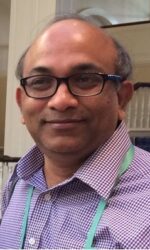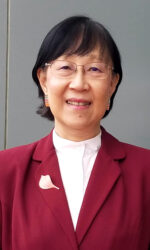UAMS Testing New Noninvasive Device for Diagnosing Fetal Heart Conditions
| LITTLE ROCK — Three grants in six months from the National Institutes of Health (NIH) are helping University of Arkansas for Medical Sciences (UAMS) researcher Hari Eswaran, Ph.D., explore promising noninvasive methods for diagnosing serious fetal health conditions.
The grants total $4.4 million and support his pioneering work with sensor arrays that can reveal important functional details of fetal development in the later stages of pregnancy. The NIH grants are just part of Eswaran’s externally supported research, which totals $12.8 million in active funding.
Eswaran is a professor and vice chair for research in the College of Medicine Department of Obstetrics and Gynecology and director of research at the UAMS Institute for Digital Health & Innovation. His use of innovative, noninvasive imaging technology known as magnetoencephalography allows clinicians to visualize changes in the functional activities of developing organs of the fetus and the stress imposed on the mother’s tissues and organs during pregnancy and childbirth.
“Dr. Eswaran’s research is a perfect example of integrating physical and engineering sciences with biomedical sciences to advance clinical practice and health care,” said Shuk Mei Ho, Ph.D., UAMS vice chancellor for Research and Innovation.
His most recent four-year $1.5 million NIH award in March makes Eswaran among the first in the world to fully test a new technology for fetal health diagnoses that would be much more affordable for hospitals.
Called an optically-pumped magnetometer (OPM), the device initially will be tested for its effectiveness detecting fetal heart conditions. Congenital heart defects are the most common birth defects, affecting nearly 1% or about 40,000 births each year in the United States, according to the Centers for Disease Control and Prevention.
Eswaran’s preliminary data from earlier OPM testing was used to secure the NIH grant.
“We found that the OPM device performed just as well as the existing technology,” he said.
Ultimately, he hopes that hospitals around the globe will soon be able to purchase the more affordable fetal testing machine.
“It has always been my dream to have a device that is much smaller and much less expensive than our current system,” Eswaran said. “The upfront cost and cost of operation right now are such drawbacks that today only a few hospitals in the world have one.”
Clinical Optimism
Eswaran’s clinical collaborator on the study, Elijah Bolin, M.D., also expressed optimism about the OPM technology.
“As a practicing fetal cardiologist, OPM offers significant promise in its ability to diagnose lethal heart rhythm disturbances in utero,” said Bolin, an associate professor in the College of Medicine Department of Pediatrics, Division of Pediatric Cardiology. “We are hopeful that many fetuses will benefit with further implementation of this technology.”
The new OPM machine, a prototype designed to Eswaran’s specifications, is encased in a sky blue rectangular metal compartment big enough for an expectant mother to lie down on a cushioned sliding table with a donut hole for her abdomen.
Only steps from the Labor and Delivery area, the system is in a small room adjacent to its first-generation cousin — a mammoth cryogenic liquid helium-cooled machine that requires a magnetically shielded room. Known as SARA (Superconducting Quantum Interference Device (SQUID) Array for Reproductive Assessment), the device has been at UAMS since 2000. Eswaran led SARA’s establishment and has received continuous NIH funding for its operation and numerous research studies.
SQUID-based systems like SARA remain the world’s gold standard for noninvasive assessments of fetal development, but the new OPM system may be a potential low-cost alternative. The older system costs about $2 million compared with $200,000 for a new OPM system, Eswaran said. The cost of the liquid helium to cool the SARA sensors is about $6,000 a month.
The OPM system’s other major advantage is its flexibility; researchers or clinicians can place the sensor array closest to where the fetus is positioned in the womb. This means fewer sensors are needed. The fixed SARA device has 151 sensors while the OPM device has just 24.
In addition to the OPM grant, Eswaran recently secured two other NIH grants to support studies using the SARA system. They are:
- A $1.5 million grant that will help gain important insights about fetal neurodevelopment in a study with diabetic pregnant mothers.
- A $1.36 million grant for a study to detect weaknesses in a pregnant woman’s pelvic floor muscles that could lead to injury while giving birth.
“Dr. Eswaran’s recent expansion of his work to study the impact of diabetes, both Type 1 and 2, on fetal brain activity, is part of a critical concept related to early-life origin of health and disease in later life,” Ho said. “This approach has reaped significant revenue allowing him and his team to obtain three NIH R01 grants within a six-month period.”
UAMS is the state’s only health sciences university, with colleges of Medicine, Nursing, Pharmacy, Health Professions and Public Health; a graduate school; a hospital; a main campus in Little Rock; a Northwest Arkansas regional campus in Fayetteville; a statewide network of regional campuses; and seven institutes: the Winthrop P. Rockefeller Cancer Institute, Jackson T. Stephens Spine & Neurosciences Institute, Harvey & Bernice Jones Eye Institute, Psychiatric Research Institute, Donald W. Reynolds Institute on Aging, Translational Research Institute and Institute for Digital Health & Innovation. UAMS includes UAMS Health, a statewide health system that encompasses all of UAMS’ clinical enterprise. UAMS is the only adult Level 1 trauma center in the state. U.S. News & World Report recognized UAMS Medical Center as a Best Hospital for 2021-22; ranked its ear, nose and throat program among the top 50 nationwide for the third year; and named five areas as high performing — colon cancer surgery, diabetes, hip replacement, knee replacement and stroke. Forbes magazine ranked UAMS as seventh in the nation on its Best Employers for Diversity list. UAMS also ranked in the top 30% nationwide on Forbes’ Best Employers for Women list and was the only Arkansas employer included. UAMS has 3,047 students, 873 medical residents and fellows, and six dental residents. It is the state’s largest public employer with more than 10,000 employees, including 1,200 physicians who provide care to patients at UAMS, its regional campuses, Arkansas Children’s, the VA Medical Center and Baptist Health. Visit www.uams.edu or www.uamshealth.com. Find us on Facebook, Twitter, YouTube or Instagram.


